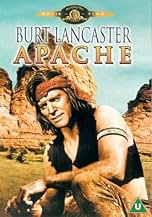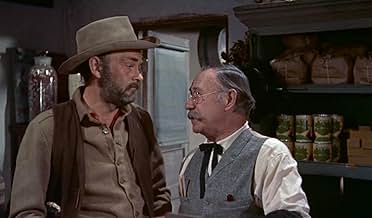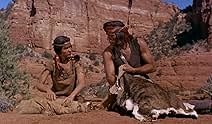CALIFICACIÓN DE IMDb
6.3/10
5.3 k
TU CALIFICACIÓN
Massai, un guerrero apache, se niega a dejar que lo reasenten en una reserva de Florida y escapa de sus captores y regresa a su tierra natal para convertirse en un granjero pacífico.Massai, un guerrero apache, se niega a dejar que lo reasenten en una reserva de Florida y escapa de sus captores y regresa a su tierra natal para convertirse en un granjero pacífico.Massai, un guerrero apache, se niega a dejar que lo reasenten en una reserva de Florida y escapa de sus captores y regresa a su tierra natal para convertirse en un granjero pacífico.
- Dirección
- Guionistas
- Elenco
Charles Bronson
- Hondo
- (as Charles Buchinsky)
Dehl Berti
- Cherokee Householder
- (sin créditos)
Paul E. Burns
- General Store Proprietor
- (sin créditos)
Lonnie Burr
- Indian Boy
- (sin créditos)
Jerado Decordovier
- Apache
- (sin créditos)
John George
- Shoeshine Man
- (sin créditos)
Anne Kunde
- Townswoman Leaving Trading Post
- (sin créditos)
Rory Mallinson
- Citizen Noticing Handcuffs
- (sin créditos)
Mort Mills
- Sergeant of the Guard Fort.
- (sin créditos)
- Dirección
- Guionistas
- Todo el elenco y el equipo
- Producción, taquilla y más en IMDbPro
Opiniones destacadas
RELEASED IN 1954 and directed by Robert Aldrich, "Apache" is based on the real-life story of Massai (Burt Lancaster), a Chiricahua Apache who was exiled with other Apaches to a reservation in Florida to be held with Geronimo and Chihuahua, but he escapes the train somewhere near St. Louis and travels 1200 miles back to the Mescalero Apache tribal area, conducting one-man raids near what is now the Arizona-New Mexican border. John McIntire plays the chief of scouts commissioned to capture Massai while Charles Bronson (Buchinsky) is on hand as an Apache scout. Jean Peters plays an Apache babe who, in real life, was Zanagoliche.
Massai actually escaped the prison train with a Tonkawa Native named Gray Lizard and they traveled the long journey back by foot together, eventually parting company in Southeastern Arizona. Gray Lizard is, unfortunately, completely omitted in the film.
To enjoy this movie you have to look past Lancaster in the lead role or, at least, imagine him to look more like a real Apache. But, keep this in mind: Since Massai is the sympathetic protagonist of the story the movie would've never been made in the early 50s without a known Hollywood star playing the role. Why? Simple: Producers needed to attract viewers in order for the film to make money. Actually, Lancaster isn't too unbelievable in the role, as long as you can disregard his blue eyes. Unfortunately babelicious Peters looks way too European to play an Apache squaw, even though they tried to hide it by darkening her skin. On the positive side, there are a lot of real Natives in peripheral roles.
The whole first act is great as Massai is a fish-out-of-water in the city of St. Louis. Unfortunately there are dull stretches in the second and third acts. Nevertheless, "Apache" was better than I thought it would be and inspired me to look up the real-life Massai. It was also a hit at the box office despite falling into relative obscurity since then. The score is surprisingly bearable for an old Western.
"Apache" made Native Americans (who aren't really 'native' since their ancestors emigrated from Asia) sympathetic characters in cinema, along with earlier Westerns, like "Buffalo Bill" (1944), "Fort Apache" (1948) and "Broken Arrow" (1950) and later Westerns, like "The Last Wagon" (1956), "A Man Called Horse" (1970) and "I Will Fight No More Forever" (1975).
THE FILM RUNS 1 hours & 31 minutes and was shot in California, Arizona and New Mexico. WRITERS: James R. Webb wrote the script based on Paul Wellman's novel.
GRADE: B-
Massai actually escaped the prison train with a Tonkawa Native named Gray Lizard and they traveled the long journey back by foot together, eventually parting company in Southeastern Arizona. Gray Lizard is, unfortunately, completely omitted in the film.
To enjoy this movie you have to look past Lancaster in the lead role or, at least, imagine him to look more like a real Apache. But, keep this in mind: Since Massai is the sympathetic protagonist of the story the movie would've never been made in the early 50s without a known Hollywood star playing the role. Why? Simple: Producers needed to attract viewers in order for the film to make money. Actually, Lancaster isn't too unbelievable in the role, as long as you can disregard his blue eyes. Unfortunately babelicious Peters looks way too European to play an Apache squaw, even though they tried to hide it by darkening her skin. On the positive side, there are a lot of real Natives in peripheral roles.
The whole first act is great as Massai is a fish-out-of-water in the city of St. Louis. Unfortunately there are dull stretches in the second and third acts. Nevertheless, "Apache" was better than I thought it would be and inspired me to look up the real-life Massai. It was also a hit at the box office despite falling into relative obscurity since then. The score is surprisingly bearable for an old Western.
"Apache" made Native Americans (who aren't really 'native' since their ancestors emigrated from Asia) sympathetic characters in cinema, along with earlier Westerns, like "Buffalo Bill" (1944), "Fort Apache" (1948) and "Broken Arrow" (1950) and later Westerns, like "The Last Wagon" (1956), "A Man Called Horse" (1970) and "I Will Fight No More Forever" (1975).
THE FILM RUNS 1 hours & 31 minutes and was shot in California, Arizona and New Mexico. WRITERS: James R. Webb wrote the script based on Paul Wellman's novel.
GRADE: B-
I grew up watching westerns so in turn love them dearly....they tie me in with a great childhood when things were simple and life was good in an unadulterated sense.
Burt Lancaster has always been a prominent actor and his talent is so very showing in this movie. Charles Bronson is also in the movie and comes across very well as a young actor who is later destined to be one of the greatest actors of our time. I thoroughly enjoyed watching this movie on a lazy Saturday afternoon and I highly recommend it for its soothing effects of a simple yesteryear long gone except in cinema.
It is a typical plot of indians being pushed out and destroyed by the Union Army with one stand out rebel.....hell bent with an anger created thru intense hate, yet capable of showing love towards the woman in his life.
Burt Lancaster has always been a prominent actor and his talent is so very showing in this movie. Charles Bronson is also in the movie and comes across very well as a young actor who is later destined to be one of the greatest actors of our time. I thoroughly enjoyed watching this movie on a lazy Saturday afternoon and I highly recommend it for its soothing effects of a simple yesteryear long gone except in cinema.
It is a typical plot of indians being pushed out and destroyed by the Union Army with one stand out rebel.....hell bent with an anger created thru intense hate, yet capable of showing love towards the woman in his life.
The movie tells the story of a rebellious apache who refuses to surrender with his chief Geronimo,and wages a one-man war against the U.S. cavalry.
Following movies like "Broken Arrow (1950)" this film takes the side of the Indian.Lancaster is again at his most athletic in the leading role,but he makes a rather unlikely Indian.The same could be said of Jean Peters,who nevertheless looks ravishing as Lancaster's squaw.It's anyway an entertaining movie.
Following movies like "Broken Arrow (1950)" this film takes the side of the Indian.Lancaster is again at his most athletic in the leading role,but he makes a rather unlikely Indian.The same could be said of Jean Peters,who nevertheless looks ravishing as Lancaster's squaw.It's anyway an entertaining movie.
If you can suspend disbelief that Burt Lancaster and Jean Peters are Apaches, then this isn't a bad western. If you can't, well then there's gonna be a lot of low ratings posted here.
In 1886, Geronimo and his braves surrender to the U.S. Calvary in New Mexico and are shipped off to Ft. Marion, Florida. All except one, an Apache named Massai (Burt Lancaster) who begins a one man war against the whites.
Massai escapes from the train that is shipping the Apaches back east and makes his way back to New Mexico. From there, he attacks wagons, soldiers, bridges etc., making life hard for the authorities. He kidnaps Nalinle (Jean Peters) and takes her up to the hills with him while Indian scouts John McIntire and Charles Bronson hunt them down.
Massai finds an isolated spot in the high country and starts to plant a small corn field from seed he got from a Cherokee farmer (Morris Ankrum). He also gets Peters pregnant with child.
The ending scene in Massai's little cornfield is pure Hollywood. The action scenes are tight as we see Lancaster jumping from rock to rock as he picks off at least 10 of the Indian scouts that have him surrounded. But then as Massai is wounded and runs into McIntire in the cornfield, disbelief occurs and the conclusion seems tacked on in order to make a happy ending out of it. You'll have to see it for yourself.
Still, it's entertaining enough as it is. It's based on a true incident and Lancaster at least brings some dignity to his role as the noble warrior turned farmer who wants to be left in peace. It could've turned out a lot worse.
I give it a 6 out of 10 for his performance alone.
In 1886, Geronimo and his braves surrender to the U.S. Calvary in New Mexico and are shipped off to Ft. Marion, Florida. All except one, an Apache named Massai (Burt Lancaster) who begins a one man war against the whites.
Massai escapes from the train that is shipping the Apaches back east and makes his way back to New Mexico. From there, he attacks wagons, soldiers, bridges etc., making life hard for the authorities. He kidnaps Nalinle (Jean Peters) and takes her up to the hills with him while Indian scouts John McIntire and Charles Bronson hunt them down.
Massai finds an isolated spot in the high country and starts to plant a small corn field from seed he got from a Cherokee farmer (Morris Ankrum). He also gets Peters pregnant with child.
The ending scene in Massai's little cornfield is pure Hollywood. The action scenes are tight as we see Lancaster jumping from rock to rock as he picks off at least 10 of the Indian scouts that have him surrounded. But then as Massai is wounded and runs into McIntire in the cornfield, disbelief occurs and the conclusion seems tacked on in order to make a happy ending out of it. You'll have to see it for yourself.
Still, it's entertaining enough as it is. It's based on a true incident and Lancaster at least brings some dignity to his role as the noble warrior turned farmer who wants to be left in peace. It could've turned out a lot worse.
I give it a 6 out of 10 for his performance alone.
Very good classic western that has a Holywood formula but with more than the usual edge.Showcasing the Native American side here during the late 19th century.Great chemistry between the lead actors.The production was nothing spectacular but was very good enough over all due mainly to the script and performance of Lancaster and Peters.Good action mixed with a cute and convincing love story.Only for liberal minded people who love Westerns and big fans of the lead actors......
¿Sabías que…?
- TriviaMassai was born to Little Sun and White Shadow at Mescal Mountain, Arizona, near Globe. He later met Geronimo, who was recruiting Apaches to fight American soldiers. He also knew the Apache Kid. The policy in Arizona at the time was to exterminate hostile Apaches. Many Apache warriors fought for their people and traditions, fleeing and waging effective guerrilla warfare against their enemies.
Massai escaped over the border to Mexico, eventually settling in the Sierra Madre mountains in Sonora Mexico with a camp of rebellious Chiricahuas who had refused to surrender with Geronimo. Nothing is known of his final days.
- ErroresAbout 16 minutes into the movie as Massai (Burt Lancaster) is fleeing from the white mob through a hotel corridor you can see an unlit electric 'EXIT' sign visible in the hallway at the top of the shot.
- Créditos curiososOpening credits: This is the story of Massai, the last Apache warrior. It has been told and re-told until it has become one of the great legends of the Southwest. It began in 1886 with Geronimo's surrender.
- ConexionesFeatured in Bearing Witness, Native American Voices in Hollywood (2024)
Selecciones populares
Inicia sesión para calificar y agrega a la lista de videos para obtener recomendaciones personalizadas
- How long is Apache?Con tecnología de Alexa
Detalles
- Fecha de lanzamiento
- País de origen
- Idioma
- También se conoce como
- Bronco Apache
- Locaciones de filmación
- Productoras
- Ver más créditos de la compañía en IMDbPro
Taquilla
- Presupuesto
- USD 1,240,000 (estimado)
- Total a nivel mundial
- USD 7,228
- Tiempo de ejecución
- 1h 31min(91 min)
- Relación de aspecto
- 1.37 : 1
Contribuir a esta página
Sugiere una edición o agrega el contenido que falta





































